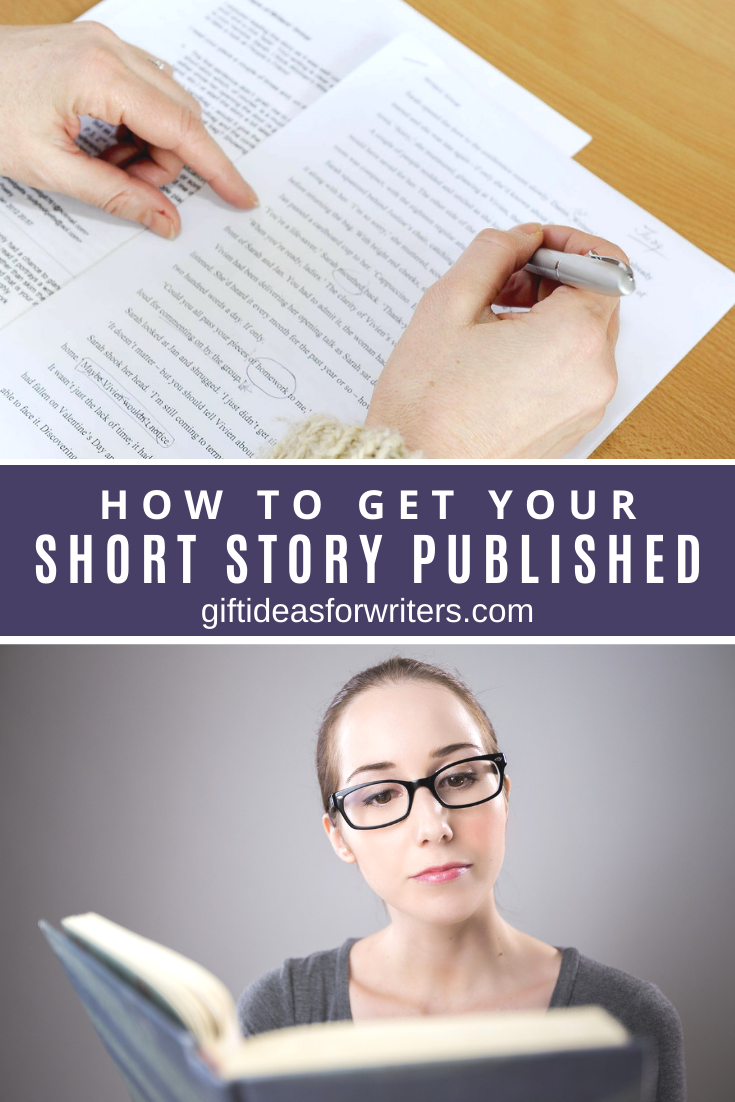One of the biggest hurdles for new and aspiring writers if getting that first publication credit. Most creative writing students aim for writing short fiction. It works well with traditional writing classes and there’s plenty of opportunities to get short fiction published. If you’re thinking about writing a short story or have one ready to send out to magazines and anthologies, this article will cover everything you need to know to publish your short story traditionally in a magazine or on a website.

1. Write the Story
This is the most obvious step, but it’s often the biggest hurdle for people who are trying to get from “I want to be a writer” to “I am a writer.” It’s easy to come up with clever ideas, the real challenge is writing them down. Set a writing goal and get your first draft done. Then celebrate with a little treat or a small gift and put the story away for a few weeks.
2. Revise, Revise, Revise
You may feel like the first draft of your story is brilliant, but to be very honest with you, it’s not. If you send out the first draft on submission there will be a lot of form rejections in your future.
This is why I recommend you put the story away for a few weeks. It allows you to look at the manuscript with fresh eyes, so you can see what is missing from the page. Rewrite your story once or twice until you feel like it is as good as you can make it. Then give it to some readers for critique. If you’re in a writing class or group, then you’re all set. Otherwise, look for friends who read regularly. Don’t give your story to your mom who will be inclined to praise anything you do. If you don’t have anyone you know to crit your story, there are many online critique groups and forums where you can trade stories with other writers in your genre.

3. Proofread
Notice how this is a separate step. That’s because proofreading is incredibly important. There’s nothing that can trip up a slush reader or editor faster than typos, misspellings, and incorrect word usage. We want them to be completely enthralled in your story, so the manuscript should be as clean as possible.
At a minimum, you should run spell check on your document and read through it again to correct any errors. I recommend printing the story out or changing the font–this small trick will make it easier to find errors your eyes might otherwise glide over. If you have a friend who is also a writer or thrives at grammar, as them to proofread your story.
You can also utilize editing software like Prowriting Aid to help you proofread your manuscript.
4. Find a Market
Now that your story is it’s absolute best, you need to find the best market for it. If you’re writing short fiction you should be reading contemporary short fiction and the magazines you’d like to publish in. If you’re still learning, you can use databases like Duotrope or The Submission Grinder to find markets that publish the types of stories you like.
Make sure to read an issue of each market you’re considering to get a sense of what kind of stories the editors publish. If all of their stories are very serious, you probably won’t be able to sell them your humorous flash fiction. Take a peek at their submission guidelines while you’re there. Many editors will list what kinds of stories they’re looking for and the ones they absolutely do not want to read. Make note of their pay rates as well.
Keep a list (a spreadsheet is great for this) of potential markets to submit to. Include details like the editor’s name, their pay rate, word count limits, open submission dates, etc. Since you may want to submit to markets that don’t allow simultaneous submissions, it’s helpful to prioritize the markets for the order you want to submit it. I recommend sending your story to more prestigious or higher paying markets first (also take into account response time) and then work your way down the list.
5. Follow the Submission Guidelines
Slush readers and editors who are overwhelmed with submissions may be subconsciously looking for reasons to reject your story. You want your story to get a fair evaluation, so follow the magazine’s guidelines, even if it means reformating your story or rewriting your cover letter.
The submission guidelines for each market will have details of how to send your story (email, submission form, etc), what format your story should be in (file type, font, etc), and what other information you should provide (cover letter, author bio, etc.).
If the guidelines don’t specify what format to submit a story in, generally it is safe to send a Microsoft Word .doc file in Shunn Manuscript Format.
If you’ve never written a cover letter before, author and editor Alex Shvartsman has a great guide.
6. Submit & Track
You’ve prepped your manuscript, polished your cover letter, it’s time to submit! Send your story to your chosen market (and if they allow simultaneous submissions, send it to a few more, too). Make sure you keep track of when and where you send what stories. You can use the trackers on Duotrope or The Submission Grinder, or use a submission tracker spreadsheet.
7. Wait
Unfortunately, there’s a lot of waiting in the writing game. Duotrope and The Submission Grinder can give you a good idea of a market’s average turn around time. While you’re waiting, this is the perfect time to start a new story or novel. It will help distract you from the waiting game and help you get another story for submission.

8. Get Your Response
If you’ve just started submitting your writing, it’s highly likely that your first responses are going to be rejections. This can be extremely discouraging, but it’s part of the writing life. When you get a rejection you should always get a reward (a favorite candy bar or other small purchase) and then send that story right back out on submission again.
Many writers feel inclined to rewrite a story every time it’s rejected. I would caution against this impulse for a few reasons. 1. There are a hundred reasons why an editor might have rejected your story (The story is awesome but they just published a zombie story or they don’t like romance or they could only buy four stories and yours was the fifth). Unless you got a personal rejection telling you why they didn’t buy it, you can’t know what the issue was. 2. Focusing your energy too much on rewriting one story over and over again can ultimately just frustrate a writer. True progress and growth are made by writing new stories and developing your skills further.
In my opinion, it’s safe to consider rewriting your story if you get personalized critique from an editor that you agree with (eg. the ending doesn’t work, the character arc doesn’t make sense). You may also want to consider revisiting the story if you’ve received five or more rejections.
9. Publish Your Story
If you keep it up, repeating these steps by writing and submitting new stories, eventually you will make your first sale! Congratulations! Make sure to celebrate with a nice dinner or a fancy writing gift.
And then, it’s time to start writing again.
Need some writing inspiration? Check out the best books on writing fiction and tools that destroy writer’s block.
